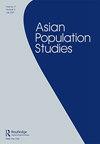Factors associated with regional variation in disability-free life expectancy based on functional difficulty among older persons in the Philippines
IF 1.5
4区 社会学
Q2 DEMOGRAPHY
引用次数: 1
Abstract
ABSTRACT This study describes regional differences in the prevalence of functional difficulty among older persons in the Philippines. Using this measure, the study examines regional variation in disability-free life expectancy (DFLE) and investigates the factors associated with this variation. Data are drawn from the 2010 Philippine Census of Population and Housing and the 2010 Philippine regional life tables. Disability-free status is defined as having no functional difficulties and is based on the binary composite of six individual functional difficulties, with no difficulties being contrasted with any difficulty. The Sullivan Method is employed to calculate DFLE and a series of bivariate meta-regression models are used to identify the socioeconomic factors associated with regional variation in DFLE. Results show substantial regional disparity in functional difficulty and DFLE among older men and older women. The population-level socioeconomic indicators associated with regional DFLE include the prevalence of poverty, GDP per capita, urbanisation, doctor to population ratio and level of education among younger adults. Associated indicators based on the older population are level of education among men and women, the labour force participation rate among men and the proportion currently married among women.菲律宾老年人基于功能困难的无残疾预期寿命区域差异的相关因素
摘要本研究描述了菲律宾老年人功能障碍患病率的地区差异。利用这一指标,该研究考察了无残疾预期寿命(DFLE)的区域差异,并调查了与这种差异相关的因素。数据来源于2010年菲律宾人口和住房普查以及2010年菲律宾地区生活表。无残疾状态被定义为没有功能性困难,基于六个个体功能性困难的二元组合,无困难与任何困难形成对比。采用Sullivan方法计算DFLE,并使用一系列双变量元回归模型来识别与DFLE区域变化相关的社会经济因素。结果显示,老年男性和老年女性在功能困难和DFLE方面存在显著的地区差异。与地区DFLE相关的人口水平社会经济指标包括贫困率、人均GDP、城市化、医生与人口的比例以及年轻人的教育水平。基于老年人口的相关指标是男性和女性的教育水平、男性的劳动力参与率以及女性中目前已婚的比例。
本文章由计算机程序翻译,如有差异,请以英文原文为准。
求助全文
约1分钟内获得全文
求助全文
来源期刊

Asian Population Studies
DEMOGRAPHY-
CiteScore
3.30
自引率
14.30%
发文量
12
期刊介绍:
The first international population journal to focus exclusively on population issues in Asia, Asian Population Studies publishes original research on matters related to population in this large, complex and rapidly changing region, and welcomes substantive empirical analyses, theoretical works, applied research, and contributions to methodology.
 求助内容:
求助内容: 应助结果提醒方式:
应助结果提醒方式:


